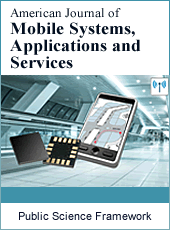American Journal of Mobile Systems, Applications and Services
Articles Information
American Journal of Mobile Systems, Applications and Services, Vol.1, No.2, Oct. 2015, Pub. Date: Aug. 23, 2015
Selection of Mobile Telecommunications Companies in Portfolio Optimization with Mean-Variance Model
Pages: 119-123 Views: 4452 Downloads: 1464
[01]
Lam Weng Siew, Centre for Business and Management, Department of Physical and Mathematical Science, Faculty of Science, Universiti Tunku Abdul Rahman, Perak Campus, Kampar, Perak, Malaysia.
[02]
Lam Weng Hoe, Centre for Business and Management, Department of Physical and Mathematical Science, Faculty of Science, Universiti Tunku Abdul Rahman, Perak Campus, Kampar, Perak, Malaysia.
Mobile telecommunications companies offer the network communication services to the users around the world. Maxis Berhad, Digi. Com, Telekom Malaysia and Axiata Holdings are the four mobile telecommunications companies listed on main market in Malaysia stock market. Investors can get return from investing in these mobile telecommunications companies by constructing the optimal portfolio. The selection of mobile telecommunications companies in a portfolio can be done by applying the mean-variance model. The objective of this paper is to determine the optimal portfolio composition and performance for the mobile telecommunications companies in Malaysia using mean-variance model. The results of this study show that the optimal portfolio consists of four mobile telecommunications companies with different weights to achieve the target weekly return of 0.1577% at minimum risk of 1.3226%. This implies that the mean-variance model can be applied effectively in the investment of mobile telecommunications companies in Malaysia. The significance of this study is to determine the optimal portfolio for the mobile telecommunications companies in Malaysia to achieve positive target return at minimum risk.
Mean Return, Risk, Optimal Portfolio, Mobile Telecommunications Companies
[01]
Clark, M. P. (1997). Networks and Communications: Design and Operation. Second Edition, Germany, John Wiley & Sons.
[02]
Alam, N., Jafirullah, K. J. and Hossain, A. (2012). Analytical Hierarchy Process (AHP) Approach on Consumers Preferences for Selecting Telecom Operators in Bangladesh. Information and Knowledge Management Vol. 2(4), pp 7-18.
[03]
Ajay, Kumar, Ravi S., and Debnath, R.M. (2015). Analyzing Customer Preference And Measuring Relative Efficiency In Telecom Sector: A Hybrid Fuzzy AHP/DEA Study. Telematics and Informatics Vol. 32, pp 447-462.
[04]
Lam, W. S., Leong, W. B., and Lam, W. H. (2015). Selection of Mobile Network Operator Based on Multi-Criteria Decision Making Model using Analytic Hierarchy Process. Mathematics and Statistics Journal Vol. 1(1), pp. 12-18.
[05]
Leisen, B. and Vance, C. (2001). Cross-national Assessment of Service Quality in the Teecommunication Industry: Evidence from Evidence from the USA and Germany. Managing Service Quality Vol 11(5), pp 307-317.
[06]
Lai, F., Hutchinson, J., Li, D. and Bai, C. (2007). An empirical assessment and application of SERVQUAL in mainland China’s mobile communication industry. International Journal of Quality & Reliability Management Vol 24(3), pp 244-262.
[07]
Kollmann T. (2000). The Price/Acceptance Function : Perspectives of a Pricing Policy in European Telecommunication Markets. European Journal of Innovation Management Vol 3(1), pp 7-14.
[08]
Gitman, L. J., Joehnk, M. D. and Smart, L. J. (2011). Fundamentals of Investing. 11th Edition, Pearson.
[09]
Reilly, F. K. and Brown, K. C. (2012). Investment Analysis and Portfolio Management. 10th Edition, Mason, South Western Cengage Learning.
[10]
Taha, H. A. (2011). Operations Research: An Introduction. 9th Edition, New Jersey, Prentice Hall.
[11]
Lam, W. S. and Lam, W. H. (2015). Portfolio Selection for Index Tracking Problem in Malaysian Stock Market. International Journal of Administration and Governance, vol. 1(3), pp. 15-17.
[12]
Lam, W. S., Saiful, J. and Hamizun, I. (2014). Comparison between Two Stage Regression Model and Variance Model in Portfolio Optimization. Journal of Applied Science and Agriculture vol. 9(18), pp. 36-40.
[13]
W. S. Lam, H. J. Saiful, and I. Hamizun (2014). Index Tracking Modelling in Portfolio Optimization with Mixed Integer Linear Programming. Journal of Applied Science and Agriculture vol. 9(18), pp. 47-50.
[14]
Lam, W. S., Saiful, J. and Hamizun, I. (2015). The impact of human behavior towards portfolio selection in Malaysia. Procedia of Social and Behavioral Sciences vol. 172, pp. 674-678.
[15]
Lam, W. S., Saiful, J. and Hamizun, I. (2015). Investigation on relationship between human behavior and portfolio selection problem in Malaysia. Advances in Environmental Biology vol. 9(7), pp. 6-10.
[16]
Lam, W. S., Saiful, J. and Hamizun, I. (2015). An empirical study on the characteristics on high risk aversion behavior in portfolio decision making, Advances in Environmental Biology vol. 9(7), pp. 17-20.
[17]
Saiful, J., Lam, W. S. and Hamzun, I. (2015). A New Optimization Model in Enhanced Index Tracking Problem with Goal Programming Approach and Entropy Measure. Wulfenia Journal vol. 22(1), pp. 356-363.
[18]
Markowitz, H. M. (1952). Portfolio Selection. Journal of Finance vol. 7, pp. 77-91.
[19]
Lam, W. H., Saiful, J. and Zaidi, I. (2010). An empirical comparison of different risk measures in portfolio optimization. Business and Economic Horizons vol 1, pp. 39-45.
[20]
Lye, C. T. and Nurul, A. M. (2011). Performance of listed state-owned enterprises using Sortino Ratio optimization. Journal of Applied Sciences vol 11, pp. 3436-3441.
[21]
Konno, H. and Yamazaki, H. (1991). Mean-absolute deviation portfolio optimization model and ITS applications to Tokyo stock market. Management Science vol 37(5), pp. 519-531.
[22]
Bodie, Z., Kane, A. and Marcus, A. J. (2008). Investments. 7the Edition, New York, McGraw-Hill.
[23]
Jones, C. P. (2010). Investments Principles and Concepts. 11th Edition, John Wiley & Sons.

ISSN Print: 2471-7282
ISSN Online: 2471-7290
Current Issue:
Vol. 5, Issue 1, March Submit a Manuscript Join Editorial Board Join Reviewer Team
ISSN Online: 2471-7290
Current Issue:
Vol. 5, Issue 1, March Submit a Manuscript Join Editorial Board Join Reviewer Team
| About This Journal |
| All Issues |
| Open Access |
| Indexing |
| Payment Information |
| Author Guidelines |
| Review Process |
| Publication Ethics |
| Editorial Board |
| Peer Reviewers |


